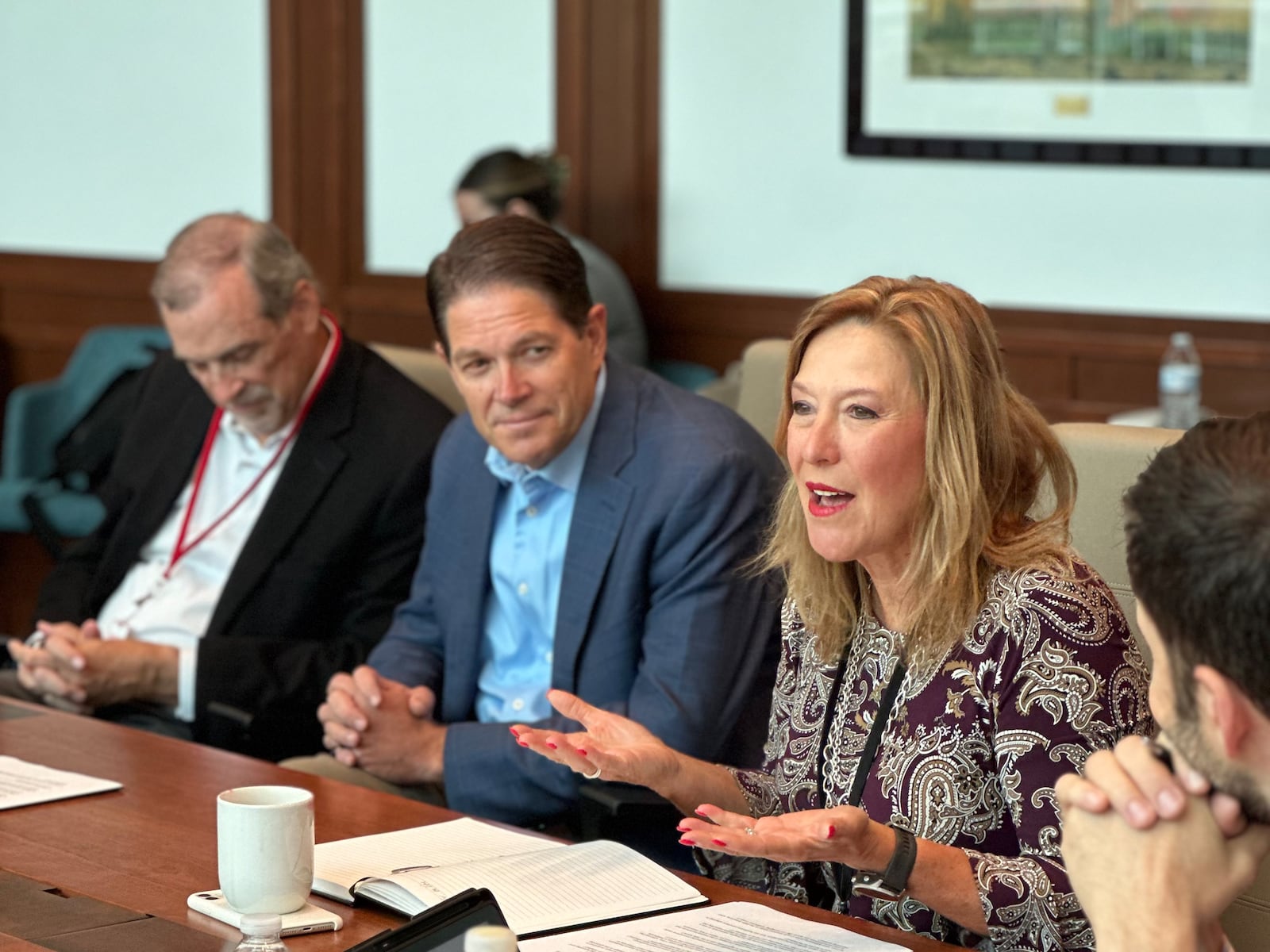This story appears in the October issue of Utah Business. Subscribe.
Last month, Utah Business partnered with Regence BlueCross BlueShield of Utah to host a roundtable featuring Utah’s healthcare leaders. This conversation was moderated by John Poelman, director of the One Utah Health Collaborative.
What is being done or can be done in Utah to reverse the trend of ever-increasing healthcare spending? What factors are influencing spending, and where are prices, costs, provider workforce costs and utilization headed?
Cole Hansen | Director, Employee Benefits | IMA Financial Group, Inc.
People don’t understand the complexity of healthcare and, for example, what does and doesn’t constitute effective utilization of a GLP-1 as defined currently, but they have the demand. The way it’s being communicated and marketed to them implies they should have it. … The reality is, when you introduce this level of innovation in the marketplace and you put that demand on individuals and then their employers to help make that a reality, that comes at a cost. And at times, it’s very difficult conversations that most healthcare consumers don’t understand.
Leah Dunn | Director, People Operations | Lucid Software
We are also coming at it as a young population. We are seeing people reach a point in their lives where they kind of go from being that young, healthy 22-year-old to now having a family. They’re experiencing that stage of life where healthcare needs start to appear. … It ultimately means that employees are dissatisfied with their employer, which is really difficult because you’re always fighting this negative culture-type situation.
Jon Pike | Insurance Commissioner | State of Utah
We have some concerns, whether it’s legitimately being done or not, about employers saying, “Well, we can’t afford this, so let’s just encourage employees to go to the individual market.” How can Regence stay in, or any other of those five in our market that are in the individual federal marketplace plan, unless there’s something that offsets that? We’ve got to deal with those kinds of issues, and we make those decisions. The state has already made some, for example, on the individual plan in terms of autism. And we projected … that would be expensive. Covering autism under the individual plan, it probably gets up there to around $10-12 million a year within a few years.
Francis Gibson | CEO & President | Utah Hospital Association
It’s difficult as a legislature because you talk about employers. We looked at, in the house, 45,000 employees that hire you to be there. Your constituents get these little support groups or advocacy groups, and they become very vocal. Even though there may not be 45,000 in one of their advocacy groups, it becomes very, very loud. Many legislators don’t understand the systems and complexities of funding these things and how it works. And so, they’re just being reactive to what their constituents are saying.

How might the key drivers of spending differ in the next five years compared to the previous five?
Scott Barlow | CEO | Revere Health
We had an employee who had a really difficult neurological issue, and the meds were $108,000 a month. Our broker worked on it really hard and pushed hard, and we got it down to $76,000 a month. Then I had our neurologist look at the case. I said, “Do you know the rep?” He said, “Yeah.” I brought the rep in. We talked to the rep, and it went down to $36,000 a month [because of] a relationship we had. The distribution models we have developed around this create an economy behind the economy that we all have to fund. [Full pricing transparency has] to be done by a regulatory bully that can force those sorts of discussions.
Laura Summers | Director, Industry Research | Kem C. Gardner Policy Institute
From a population perspective, … not only are we growing and expected to continue to grow as a state, but our demographics are going to be changing. We’re going to have an aging population. Today, one in 10 are aged 65+, and by 2050, one in five will be 65+. And that just means adding pressure, adding to demand for healthcare utilization.
Consider actions that you know employers have taken to reduce healthcare costs. What has been successful, and what has fallen short? What new or promising solutions have you seen emerging?
Cole Hansen | Director, Employee Benefits | IMA Financial Group, Inc.
When was the last time you bought a good or a service and you did not know the cost until after it had been received? … That’s what it’s like to be a healthcare consumer. If you’re going to ignite a certain level of consumerism and build a certain level of confidence with that consumer base, you need to give them reasons to engage, and you need to give them opportunities when they engage to make it meaningful. … How do we internally create opportunities that empower our employees to be confident, savvy and cost-conscious consumers with their healthcare? Because right now, we give them an ID card, and we say, “Stay in network; good luck.”
Chet Loftis | Managing Director | PEHP Health & Benefits
We’ve been in this space for a while, and it has been challenging. We provide allowed [medical care cost] amounts on our website — we have forever — so you can compare. … The initial theory was, “Let’s put these tools where patients go, and we think they go to a provider directory.” So we built them into the provider directory. We not only do it on the medical side but for everything that we do, including dental. [Patients and providers] could see what our formulary is, and they could see within that formulary the class of drugs that were interchangeable. … There may be one that’s $1,500 and one that’s $15. With the sole purpose of just talking to your provider to say, “Can I do the $15 one? You got me the $1,500 one.”
Marc Bennett | CEO & President | Comagine Health
Generally, when we’re shown cost data, we associate higher costs with higher quality. I often think of lower cost as higher quality the way I measure things. … There are a lot of ways in which we’re trying to equate the healthcare market with a market for buying cars or a market for finance, and it’s just not that. There are so many elements of it that don’t work like a market in the traditional sense. For every story of a person who’s grateful they saved money and got cash back, you’ve got people who are saying, “I’m not really responsible for my costs; my employer is or the government is. So I want the best thing.” And the best thing is, in their mind, the highest cost thing.
Leah Dunn | Director, People Operations | Lucid Software
From the employer’s side, cost transparency tools do not work at all. We will pitch them to employees time and again. You can have a very engaged, highly educated, very tech-savvy population, and it is still a struggle to try and get them to use it. … What we’ve seen to be most effective at actually lowering costs is carving out pieces of the medical plan, whatever it is that’s driving costs, and looking for a standalone solution that takes the decision-making power away from the individual.
Jon Pike | Insurance Commissioner | State of Utah
Healthcare has never really been cheap, but I think we in the industry made it seem cheap, especially on the plan side because we said $5 co-pays. I’m not ready to give up on helping individuals understand that it is not cheap; it is not $5. … We need to connect individuals to the true cost of their healthcare and the lack thereof. … We have to help people understand the consequences of living the way we do, of eating the way we do, of not exercising the way I don’t. That does have consequences that are financial and medical and shorten or lengthen our lives.
Jim Dunnigan | Insurance Broker | Dunnigan Insurance
Rep. District 36 | Utah House of Representatives
Some of my employer groups, particularly some of the blue-collar ones, are working long days, many of them working two jobs. When they come home from work, they don’t want to go online and look up costs. They want to take their kids to the soccer game or watch them play. If they’ve got some downtime, they’ve got plenty of things to fill their day. People are trying to make ends meet, and it’s hard to get them engaged. … We did an open enrollment meeting with a group. These were intelligent people, and we had an insurance company representative come out and give an overview of the plan benefits and talk about co-insurance. After they got done, I said, “By a raise of hands, how many know what co-insurance means?” Not one hand went up. That’s on us to explain it, and it’s complicated, but people have a life, and this does not top their list of what they want to do in their spare time.

Are employees skipping or delaying care due to high costs? If so, what are the long-term impacts? What innovative approaches might combat this trend of underutilization?
Dr. Donna Milavetz | Chief Medical Officer | Regence BlueCross BlueShield of Utah
Having a primary care quarterback is important in healthcare navigation. … I would submit to everyone in this room that we probably see the dentist more than the physician. So, why shouldn’t we partner? Oral health and physical health are intimately related. Why shouldn’t we expand the scope of practice in Utah to allow dentists to vaccinate? It’s an easy, low-cost alternative where you all see dentists a whole lot more than physicians. … We have to start thinking in a more disruptive way about the resources we have available in our communities.
Dr. Brent Larson | Member | Utah Oral Health Coalition Steering Committee
The University of Utah [has] integrated, for the first time in the country, dental and medical records. It’s all on the same platform. Physicians can see what the dentists are doing, and dentists can see what the physicians are doing. They did it so they could do studies and produce papers that indicate where the crossover and the influence are and eventually provide better care through more integrated information.
Francis Gibson | CEO & President | Utah Hospital Association
When I was a legislator, I remember a bill that [would have allowed] licensed psychologists, who did an extra three years of pharmacology training, to be able to write for psychotropic medication for mental health. … No one knows that patient from a mental health perspective more than the licensed psychologist who’s treated them for years and been in pharmacology training. But we were told as legislators that only an MD could prescribe that medication. Fast-forward. I’m a big proponent of nurse practitioners, as they’ve been trained, … allowing them to practice to be able to get more people in.
Laura Summers | Director, Industry Research | Kem C. Gardner Policy Institute
We did a big study on behavioral health. Coming in from the mental health and behavioral health side, which also has very significant shortages in terms of providers, we’re thinking creatively about how to better provide services there. On the mental health side, we hear about the value that peer supports [community health workers (CHWs)] add to the care team. That’s what the population wants. They trust the peer support specialists they’re working with. They want to work with more peer support specialists. So I think about meeting the consumers where they are in terms of the types of providers that they feel most comfortable meeting with.
Jenifer Lloyd | Deputy Director | Association for Utah Community Health
We’ve had to let people go — well-qualified, bilingual people doing a great job — because of a lack of funding. The value-based care conversation has been going on for many, many, many years without any real movement because it’s still fee-for-service. They don’t have a budget to really accommodate much in the way of risk, so getting the CHWs paid for is the real issue.
Scott Barlow | CEO | Revere Health
If I could redo this from scratch, the thing I would try to advocate as the number one way to make the system better is a strong primary care relationship. Change the tradition that people should have a physical every year. Create a human relationship because people change behavior based on human relationships. If it’s fragmented, you start losing that.

If you were addressing every C-suite business leader in the state tomorrow, what is one piece of advice you would offer on managing healthcare costs or improving access?
Dr. Brent Larson | Member | Utah Oral Health Coalition Steering Committee
Giving your employees choices and having them be part of the decision makes them own the consequences. … We had 15 employees in our office; it was a really small business. But we really tried to give our employees choices and have them be part of the decision and have them feel ownership. … For 35 years, we didn’t have dissatisfaction nearly as often.
Marc Bennett | CEO & President | Comagine Health
I’ve been trying, for 30 years of my career, to get employers to be engaged. They are really fickle. They become engaged, and then anything changes in the marketplace and they go away. ... If I really had the ear of all the C-suite leaders, I’d say, “Stay at the table and don’t walk away. Be in this for the long haul because the decisions you make aren’t going to be any good if you turn away from them next year or the year after.”
Chet Loftis | Managing Director | PEHP Health & Benefits
Our main objective is to help people preserve their benefits. When rates go too high, the employers won’t have any other option than to shift the cost to the employee. If we’re all in this together, it would be nice if we could talk about how to improve benefits. … We’re just trying to make it so we can continue to have what we have. You, as the employer, are trying to do the same thing. … I’m happy to say that with the legislature’s support, we [the state] have the same benefits today that we had in 2010.
Dr. Donna Milavetz | Chief Medical Officer | Regence BlueCross BlueShield of Utah
I would tell them that they actually have the power to change healthcare in our state because they employ individuals between 18 and 64, which is when chronic disease emerges. If you can do early and aggressive intervention, which doesn’t necessarily have to do with medications — it’s lifestyle medicine — you can change the trajectory of hypertension or high blood pressure. You save end-stage renal disease and dialysis costs. You save diabetic complications. You mitigate cancers because of early screening and aggressive intervention.
Jim Dunnigan | Insurance Broker | Dunnigan Insurance
Rep. District 36 | Utah House of Representatives
To many employees, perception is a reality. I have two clients. They have the same health plan and carrier, but they don’t know each other. We go to an employee meeting at one business, and they just love their plan and their employer. We go to the next employer, and they hate the plan and their employer. They have exactly the same benefits. In Plan A, the employer pays more of the cost. The employee sees that as a benefit and appreciates it. The employees with employer B have to pay a lot more. … It is a balance between salary and benefits. In today’s competitive market, benefits are really important to attract and retain qualified employees.
Jenifer Lloyd | Deputy Director | Association for Utah Community Health
Empower your employees to be healthy and walk the walk with them. I think people really look to leadership, and if you are not promoting a healthy life, they won’t either.

